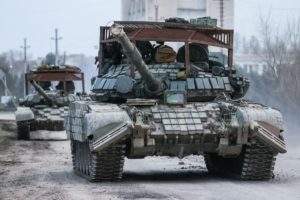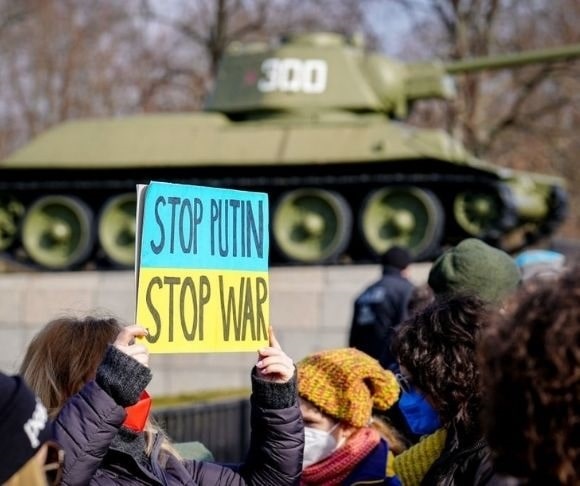A convoy of Russian military vehicles is slowly making its way to the Ukrainian capital city. Satellite imagery indicates that the procession is roughly 40 miles in length and was, at last reports, just 20 miles from Kyiv. Last night, Feb. 28, rocket attacks seemingly aimed at Ukrainian leaders were launched. Despite these increased hostilities, the ceasefire negotiations taking place at the Belarus border between the two countries will continue.
The first day of peace talks between Russian and Ukrainian officials has ended, and, while little content of the discussions has leaked, both sides agreed to continue negotiations. The announcement of a second meeting is guardedly positive news. And yet, even as the talks were in progress, numerous accounts reported large explosions within Kyiv. “The negotiations have just ended. Delegates found topics which they could agree upon next time. Now they will return to their capitals for consultations. There were 3 rounds of talks. So far, no tangible result, but they agreed to meet again on the Belarus-Poland border after consultations,” a Ukrainian Member of Parliament told Fox News.

(Photo by Sergei Malgavko\TASS via Getty Images)
With Moscow’s extremely well-equipped ground and air forces moving through the Ukraine countryside, will a peace be possible? Liberty Nation’s Mark Angelides reported, “From the Russian side, it is believed that a demand for surrender will be issued. Meanwhile, the Ukrainians are expected to ask for a ceasefire to all hostilities.” What might give the Kremlin some pause is that the Bear is not gobbling up the whole of Ukraine as quickly as some forecast.
“It is nothing short of remarkable what the Ukrainian military has accomplished,” General Jack Keane, former U.S. Army vice chief of staff, told Fox News. “But I think despite the fierceness of the Ukrainian resistance, they are overmatched by the Russians, and the Russians will eventually prevail.” Yet, the invaders are currently stalled in many parts of Ukraine, despite the three-pronged attack by hundreds of Russian tanks, armored personnel carriers, and tens of thousands of infantry.
Not cowed by Soviet-style marauders in his country or dire predictions of impending doom, standing his ground in Ukraine’s capital Kyiv, President Volodymyr Zelensky carried on business as chief executive. He signed Ukraine’s application to join the European Union (E.U.) and asked the request to be “fast-tracked.” The young leader has made known his desire to be part of Western Europe for some time. Membership in the E.U. is essential to establish the strong economic ties that will sustain Ukraine’s financial stability. Moreover, the action was a poke in Vladimir Putin’s eye since Moscow’s bellicose Big Man warned Kyiv not to join the E.U. or develop close relations with the West.
The ceasefire talks were not the only deliberations on Russia’s unprovoked invasion of Ukraine. Both deliberative bodies of the United Nations — the Security Council and the General Assembly — took up the crisis in Kyiv. The General Assembly convened an unusual “emergency session” on Feb. 28, to address Ukraine’s dire circumstances. On the same day, the 15-member Security Council met for the same reason. Ukraine’s ambassador to the United Nations told the General Assembly, “If Ukraine does not survive … international peace will not survive. If Ukraine does not survive, the United Nations will not survive. Have no illusions. If Ukraine does not survive, we cannot be surprised if democracy fails next.”
 On Feb. 25, there was a vote in the Security Council to pass a resolution calling on the Kremlin to cease its attack on Ukraine and remove Russian troops. But, predictably, the resolution failed on a vote of 11-1, with Russia casting the veto, and China, India, and the United Arab Emirates abstaining.
On Feb. 25, there was a vote in the Security Council to pass a resolution calling on the Kremlin to cease its attack on Ukraine and remove Russian troops. But, predictably, the resolution failed on a vote of 11-1, with Russia casting the veto, and China, India, and the United Arab Emirates abstaining.
Despite the persistent fighting in Ukraine, some level of a ceasefire is worth pursuing, even though history has shown that when Russia negotiates, the outcome is never settled. As evidence, in February 2015, Russia, Ukraine, and the Organization for Security and Cooperation hammered out a ceasefire in the Minsk agreements involving the Donetsk People’s Republic and Luhansk People’s Republic. It was later endorsed by the U.N. Security Council.
Nevertheless, the fighting continued in that region, fomented by Russia-backed separatists, which provided Putin with his false cover to invade now. Will further talks result in preserving Ukraine’s freedom and sovereignty?
The views expressed are those of the author and not of any other affiliation.
~ Read more from Dave Patterson.




